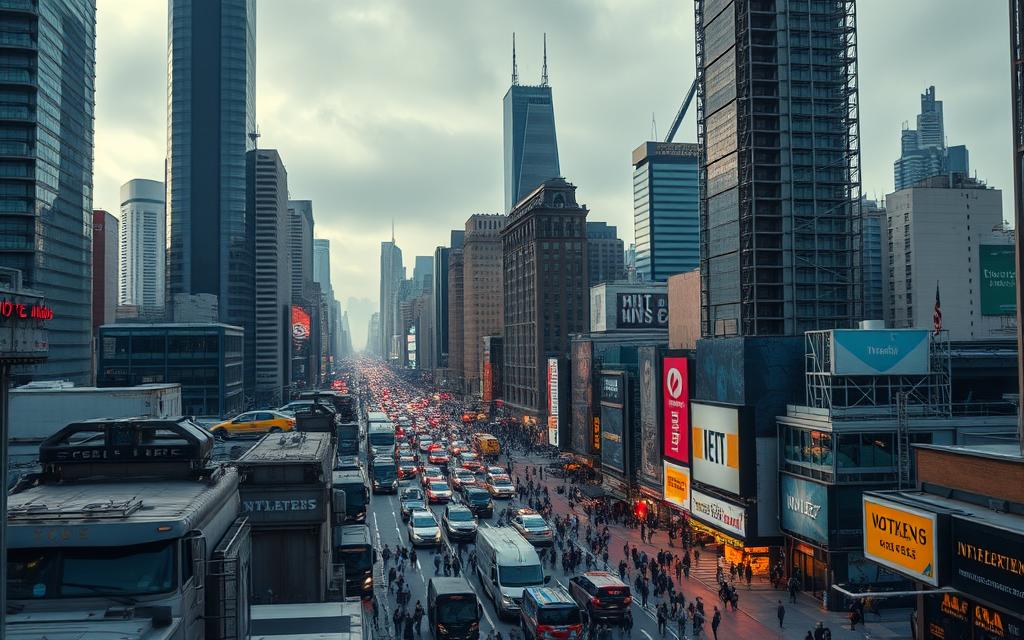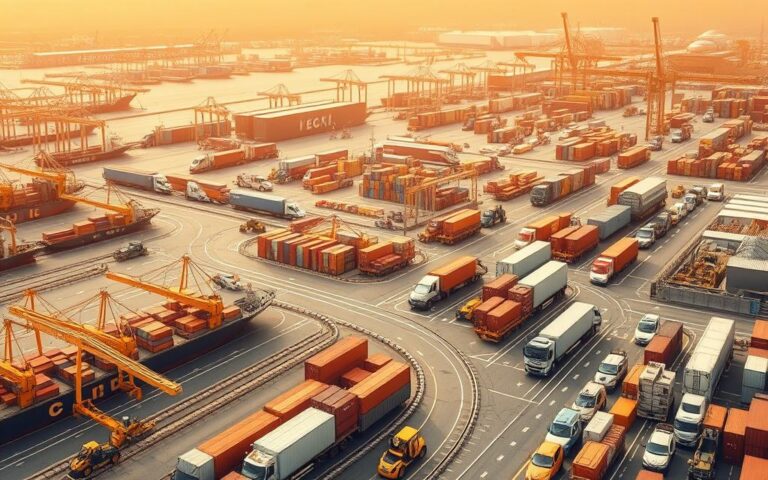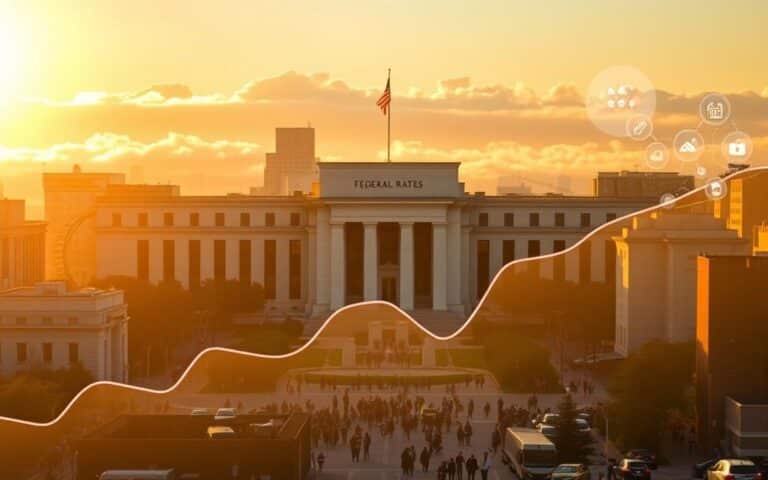People have seen their grocery bills and mortgage payments go up. This worry affects millions in the United States. It’s vital for everyone, from families to small businesses and retirees. They all need to understand what causes inflation.
Inflation means prices for goods and services rise over time, typically shown as an annual rate. It makes our money worth less. When prices increase, you can buy less with the same amount of money. Economists talk about “nominal” and “real” values. “Nominal” is what you see, while “real” values show the true buying power after removing inflation.
Related content:
You will stay on the same website.
Prices can rise for several reasons. These include demand-pull, where demand is stronger than supply. Cost-push occurs when it costs more to make things, increasing prices. Built-in inflation comes from higher wages and price expectations. Other factors like government actions, global events, and new technology also play a role.
This article will explain inflation and why prices go up. We’ll look at how demand and supply cause changes. We’ll also discuss how expectations and government actions impact prices. Moreover, we’ll explore how global events and technology affect us, focusing on their impact on U.S. consumers and investors.
Understanding Inflation: A Basic Definition

This part explains inflation simply and tells us how economists watch price changes. It talks about the main ways to see inflation in the U.S. It also tells us why we need to look at core measures and what people expect.
What is Inflation?
Inflation means prices go up making money worth less. It’s when prices for many things rise, not just one item. Headline inflation counts food and energy prices. But core inflation takes these out to better see what’s really happening.
Hyperinflation is when prices skyrocket very fast and can ruin economies. The Weimar Republic in the 1920s saw prices jumping every day. Meanwhile, after World War II, some places saw inflation that was bad but not as extreme.
Measuring Inflation: Key Indicators
The Consumer Price Index (CPI) looks at what city people pay for things. The Personal Consumption Expenditures (PCE) price index is what the Federal Reserve likes to use. And the Producer Price Index (PPI) checks the prices before items get to stores.
These measures look at certain baskets of goods and services. Some baskets stay the same, others change as people buy different things. Taking out seasonal effects and food and energy prices helps us see clearer trends.
Future inflation signs come from surveys and the Treasury Inflation-Protected Securities. These show us how people’s expectations and feelings might affect inflation. They help us understand the main causes.
| Indicator | Publisher | Focus | Policy Use |
|---|---|---|---|
| Consumer Price Index (CPI) | Bureau of Labor Statistics | Retail prices for urban consumers; headline and core series | Used for cost-of-living adjustments and public reporting |
| Personal Consumption Expenditures (PCE) | Bureau of Economic Analysis | Broader consumption weights; chained index adjusts spending patterns | Fed’s preferred measure for inflation targeting |
| Producer Price Index (PPI) | Bureau of Labor Statistics | Wholesale prices; input costs for firms | Signals supply-side pressures that can filter through to consumers |
| Inflation Expectations | University of Michigan; Treasury market | Survey measures and TIPS breakevens | Forward-looking guide to likely inflation paths and reasons for inflation fluctuations |
Demand-Pull Inflation: Demand’s Role
Demand-pull inflation happens when an economy’s demand grows faster than its supply. It’s like too much money going after too few goods. This problem might affect the whole economy or just parts of it, like housing or tech gadgets.
Definition. It occurs when everyone wants to buy more than what’s available at present prices. This causes prices to rise. You see this in higher consumer price indexes and more competition for some products.
Fiscal stimulus. Big government spending can quickly boost overall demand. The American Rescue Plan of 2021 and more unemployment benefits raised incomes. This led to more buying by people, which pushed up prices during the recovery from the pandemic.
Monetary easing. Keeping interest rates low and pumping more money into the economy makes borrowing cheaper. This encourages people and businesses to spend and invest more. Such central bank actions are key reasons behind inflation.
Pent-up and rebound spending. After lockdowns, people rushed to spend on travel, food out, and big-ticket items. This sudden rush put pressure on supply chains, adding to the inflation problem.
Wealth effects and credit. When the value of stocks and homes goes up, people feel richer. With easy credit, they’re likely to buy big, which fuels inflation even more.
Population and export demand. More people means growing demand for homes, schools, and services. If other countries want more of what we make, it can max out our production. These issues keep pushing prices up.
Consumer confidence. Feeling good about job security and earnings leads to more spending. Greater confidence and easy loans boost demand and keep inflation concerns alive in many areas.
Cost-Push Inflation: The Supply Side
Cost-push inflation means firms raise prices due to higher production costs. This can lead to less production and tighter supplies. It’s a key reason for rising prices in the economy.
Companies might increase prices when their own costs go up. How much prices go up depends on the company’s power in the market, their profits, and competition. If companies can’t handle the extra costs, consumers will see price hikes on various goods and services.
What is Cost-Push Inflation?
Cost-push inflation happens when general prices go up because it costs more to make things. This can be due to sudden supply issues or ongoing cost increases. The result is often slower economic growth unless demand can match the higher prices.
Supply shocks, like big jumps in oil prices or drops in semiconductor availability, mean higher costs for making and moving products. Companies then have to decide: make less, make less profit, or charge more.
Key Contributors to Higher Production Costs
There are many reasons costs can go up for businesses. When wages go up faster than productivity, labor costs rise. Spikes in the cost of energy, metals, and crops also make it more expensive for many industries.
From 2020 to 2022, transport costs went up because of global supply issues. Semiconductor shortages made it more costly for car and electronics makers, showing how supply bottlenecks can lead to higher prices.
New rules, tariffs, and more expensive insurance also make things more expensive for producers. To handle these costs, companies might hike up prices or cut back on things like investments and jobs.
These factors influencing inflation don’t work alone. When several costs grow at once, the effect on prices is stronger and longer-lasting.
Built-In Inflation: Expectations and Wages
Wages and prices have a tight link, causing inflation to become embedded in the economy. Workers want more pay as prices go up. Businesses then hike their prices due to the increased cost of labor. If no one steps in, this cycle can keep inflation going.
The wage-price spiral explains how the demand for higher wages and setting of prices feed into each other. When workers get bigger paychecks, companies might increase their prices to safeguard their profits. This makes prices go up even more, leading to yet another round of wage demands.
This pattern played out in the 1970s in the USA. Back then, wages kept growing, which made inflation stay high. The heavy use of collective bargaining in industries like manufacturing pushed labor costs higher. Economists often look back at this time to understand how wages influence inflation.
What people and companies think about future inflation affects their actions today. If folks expect prices to climb, they’ll want higher wages. Companies expecting to pay more will charge more and update their contracts. This change in behavior can drive expectations of inflation to become reality.
Officials keep a close eye on how the public and markets view inflation. They look at surveys like the one from the University of Michigan to see what households think. They also monitor market indicators, such as TIPS breakeven rates, which show what investors expect. These insights help figure out if people’s inflation expectations are stable or shaking.
Stable expectations help central banks keep prices under control. But if those expectations start to rise, they add to the factors that can make inflation predictions come true. Knowing how expectations, wage demands, and price-setting work together sheds light on the various causes of inflation ups and downs.
Monetary Policy and Inflation
Central banks play a big role in our economy. They affect how much we spend and the prices we see. This part explains what the Federal Reserve and other banks do to manage inflation and the economy.
Role of Central Banks in Inflation Control
The Federal Reserve has two main goals: to keep employment high and prices stable. It uses different tools like open market operations and setting reserve requirements. The Fed also gives guidance and adjusts market liquidity to help reach these goals.
These tools help keep inflation around a set point, like the 2% target in the U.S. When central banks communicate clearly, their policies work better. This helps prevent temporary issues from driving up inflation over the long term.
Interest Rates and Their Effect on Inflation
Interest rate changes impact the economy in big ways. Higher rates make borrowing more expensive, which can slow down spending. On the other hand, lower rates encourage people to borrow and spend more, pushing prices up when there’s not enough supply.
It usually takes time to see how rate changes affect inflation. Policymakers keep an eye on jobs, wages, and prices to understand this impact. For example, past actions like the ones taken in the 1980s and after the COVID-19 pandemic show us how rate changes can control inflation over time.
There are many factors that drive inflation, from wages to sudden changes in supply. Central banks have to be careful and nimble with rate changes. They aim to keep growth stable while getting inflation to their target levels.
Fiscal Policy and Government Spending
Government choices affect the economy’s performance. They use spending and taxes to influence prices. These decisions are a balance between immediate needs and future benefits.
How Government Spending Influences Prices
Spending money, giving it to people, and investing in projects increase demand. If there are not enough jobs, this can make prices go up. For instance, the American Rescue Plan of 2021 boosted demand quickly.
Different types of spending have various impacts. Money spent on things like roads and science helps us do more with less, potentially easing price rises. But, quick cash to families mostly increases what they buy, possibly causing prices to rise if there’s not enough supply.
Tax Policies and Their Inflationary Effects
Lowering taxes can put more money in people’s pockets, raising what they buy. If there’s not enough of what they want, prices might go up suddenly. For businesses, higher taxes mean higher costs that could lead to higher prices.
Aid like jobless benefits helps keep spending steady when times are tough. Yet, borrowing a lot for spending can push prices up, especially if the economy is doing well and money policy is lenient. How much this affects inflation depends on many factors, including actions by the central bank.
Exchange Rates and Inflation
Currency changes affect prices in countries that trade globally. When exchange rates shift, it changes how much we pay for imported goods. It’s important to understand how these changes impact inflation and the economy.
The Relationship Between Currency Value and Inflation
When a country’s currency value drops, imports get pricier. This means we pay more for things from abroad, pushing up prices. But if the currency gets stronger, foreign goods cost less, helping control inflation.
The effect of exchange rate changes can vary. It depends on the country and what it buys and sells. Businesses that protect themselves against currency changes can keep prices more stable.
Import Prices and Domestic Inflation
How much we pay for imports directly affects our inflation rate. Countries that depend on foreign materials see faster price changes when global costs shift.
When international costs of goods like oil go up, import prices follow, especially if these goods are sold in dollars. This can lead to higher prices for many products. In turn, this impacts what we pay in stores.
Governments and businesses watch these trends closely. They help to make decisions about interest rates and pricing strategies. It’s crucial for planning and keeping prices in check.
Global Supply Chain Disruptions
The pandemic and rising geopolitical tensions changed how goods, raw materials, and parts are moved around the world. These changes caused ongoing issues in global supply chains that affected many industries. From making cars to creating consumer electronics, everyone felt the impact.
COVID-19 hit production and shipping hard in places like China and Vietnam. Factories closing down led to a shortage of important parts. Plus, things got stuck at ports due to congestion and not enough containers.
There weren’t enough workers at docks and warehouses, which slowed things down. Semiconductor factories, like those from TSMC and Samsung, couldn’t keep up. This was tough on car and smartphone companies.
When people started buying more, factories couldn’t keep up. This mismatch caused delays and increased costs for shipping and storing goods. This added to inflation in various product areas.
Geopolitical tensions also played a role in trading and markets. Sanctions, trade fights, and the conflict between Russia and Ukraine made supplies of oil, gas, wheat, and fertilizers uncertain.
This uncertainty made it more expensive for companies who make things and for those who grow food. Trying to find new suppliers quickly or moving production caused other costs and challenges.
Companies like General Motors and Apple changed how they get and keep their supplies to deal with these uncertainties. These changes helped lower some risks but meant higher costs in the short term. These higher costs are one reason prices have been going up.
| Factor | Example | Impact on Prices |
|---|---|---|
| Factory shutdowns | Chinese electronics plants halted in 2020 | Shortages of components, higher production costs |
| Port congestion | U.S. West Coast and European ports backlog | Delayed deliveries, increased freight rates |
| Semiconductor constraints | TSMC capacity limits affecting automakers | Vehicle production cuts, higher vehicle prices |
| Energy supply shocks | Sanctions and war disrupting Russian exports | Spikes in oil and gas prices, higher manufacturing costs |
| Agricultural disruptions | Ukraine and Black Sea export interruptions | Rising food and fertilizer prices |
| Reshoring/diversification | Companies moving production closer to end markets | Higher short-term costs, reduced long-term vulnerability |
Commodities and Inflation
Raw material prices greatly impact our economy. They affect everything from energy and food markets to transportation and household expenses. These changes can lead to shifts in consumer prices and business operations.
Oil’s role in shaping inflation is significant. It powers transport, heats our homes, and is used in industries. A decrease in oil supply can quickly make transport and production more expensive. These costs then impact the prices of goods and services.
History shows how oil prices can shake economies. The 1970s saw price jumps and economic slowdowns due to OPEC’s production cuts. Recently, in 2022, energy costs soared after the conflict in Ukraine, affecting inflation worldwide.
Oil prices and inflation are closely linked. Rising crude oil prices increase costs for gasoline, diesel, and shipping. They also make petrochemicals like plastics more expensive. Firms may raise prices or reduce their output when faced with these costs, influencing jobs and spending.
Farming also affects what we pay for food. Bad weather, pests, and higher costs for things like fuel can reduce harvests. When it costs more for farmers to produce crops, food prices go up.
Food price increases hit poorer families the hardest. They spend more of their money on basic foods. So, when prices for things like wheat or corn go up, these families suffer first. This situation often puts pressure on governments to act.
Trade policies and restrictions on exports can also affect food prices. If a big exporter stops shipping out food, prices for things like grains go up worldwide. These higher prices then make it more expensive for us at the grocery store and when eating out.
The table below shows how these forces work, their historical impact, and who gets hit hardest.
| Channel | Example Drivers | Historical Episode | Who Is Most Affected |
|---|---|---|---|
| Energy costs | OPEC cuts, geopolitical risk, supply constraints | 1970s oil shocks; 2022 energy surge | Transport firms, manufacturers, consumers |
| Transport pass-through | Higher diesel/gasoline, shipping rates | Container rate spikes after 2020 supply disruptions | Retailers, importers, end consumers |
| Agricultural supply | Weather, pests, fertilizer and fuel costs | Crop failures tied to droughts and heatwaves | Low-income households, food processors |
| Trade restrictions | Export bans, tariffs, logistic blockages | Export limits on wheat and corn in past crises | Import-dependent countries, global food markets |
| Input price spillovers | Petrochemical feedstock and fertilizer costs | Fertilizer price surges after energy spikes | Agribusiness, consumers facing food inflation |
Inflation Trends in the United States
The United States has experienced big changes in how fast prices grow. This article gives a brief tour of major patterns over the years. It also looks at recent trends and predictions on inflation. This information helps us understand why inflation changes and what causes it today.
Historical Context of U.S. Inflation Rates
In the late 1970s and early 1980s, the U.S. had very high inflation. Problems with energy prices and not-so-tight money policies were main reasons. The Federal Reserve, under Paul Volcker, decided to control money more tightly. This helped bring inflation down to lower rates.
During the 1990s and 2000s, inflation was usually around 2%, which is what the Fed wanted before 2020. Wars, recessions, or big problems with supplies sometimes made inflation spike. But on average, inflation stayed low. This was because people expected it to, the world’s economy got more connected, and we got better at making things. These factors are important when we talk about the causes of inflation over time.
Recent Trends and Predictions
When the pandemic hit in 2020, it caused big changes in what people bought and what was available. There were a lot of government spending and easy money policies. In 2021 and 2022, the Consumer Price Index, or CPI, jumped up. The highest point was over 8% inflation in 2022. Problems finding workers and getting goods played a big role in these changes.
After 2022, the Federal Reserve raised interest rates to slow down spending. By the years 2023–2024, inflation started dropping closer to lower numbers again. Reports from the Bureau of Labor Statistics (CPI) and the Bureau of Economic Analysis (PCE) are what experts and decision-makers use to keep track.
Right now, it’s hard to say what will happen next. If it keeps being hard to find workers or if oil prices go up a lot, inflation might speed up again. But if it gets easier to get supplies and we can make things more efficiently, inflation could slow down. These possibilities show the big questions about what drives inflation and what will have the biggest effect.
| Period | Typical Annual Inflation Range | Primary Drivers |
|---|---|---|
| 1970s–early 1980s | 6%–14% | Oil shocks, loose monetary policy, rising wages |
| 1980s–1990s | 1%–4% | Tight monetary policy, disinflation, anchored expectations |
| 2000s–2010s | 0.5%–3% | Globalization, productivity gains, stable monetary framework |
| 2020–2022 | 1%–8%+ | Pandemic disruptions, fiscal stimulus, supply shortages |
| 2023–2024 (short-term outlook) | 2%–4% | Monetary tightening, easing supply constraints, labor market dynamics |
Impact of Inflation on Consumers
Rising prices affect our daily lives. We see inflation’s impact at grocery stores, at gas stations, and on monthly expenses. Small price hikes catch our attention first. But, larger ones become obvious when our paychecks can’t keep up.
Cost of Living Adjustments
To handle rising costs, there are cost of living adjustments (COLAs). Social Security adjusts payments using the CPI-W for yearly increases. Union contracts might link pay raises to how much inflation there is. Also, some employers and pensions raise pay to help retirees keep up.
But these efforts have their limits. Not all incomes or benefits adjust with inflation right away. Sometimes, there’s a delay which means we earn less until the next pay raise.
Inflation’s Effect on Purchasing Power
If our wages don’t increase with inflation, we can buy less. We have to cut back on extras and spend more on what we need. This hits families with lower or fixed incomes harder because they already spend more of their money on essentials.
People find ways to manage these challenges. They might pick cheaper options, wait longer to buy big-ticket items like cars, or use savings. These strategies might help for a while but can hurt finances in the long run.
It’s helpful to know why prices are going up. Things like supply issues, more demand, or higher wages can all cause inflation. Understanding these factors helps families know when COLAs can help or when they need to rethink their budgets.
Inflation and Investment Strategies
When inflation goes up, investors need to change their game plan. This guide shares tips on how to do that. It links what causes inflation to how your portfolio reacts. It also points out what usually triggers inflation in markets.
Stocks vs. Bonds During Inflation
Inflation can eat away at what you earn from bonds. Bonds give you fixed payments, but when prices rise, your money buys less unless bond yields increase too.
Stocks can go either way. Brands like Procter & Gamble or Coca-Cola can charge more and keep making money. But, companies like airlines or car makers might struggle if their costs go up due to inflation.
Bonds that adjust for inflation, like TIPS, protect you by changing their value based on the Consumer Price Index. Bond experts might also prefer bonds that don’t get affected much by interest rate hikes.
Real Estate as an Inflation Hedge
Real estate can guard against inflation since rent and property values can increase. Owning property directly lets owners adjust rents. REITs are an easy way to invest in property.
But, there are risks. Real estate doesn’t like it when mortgage rates go up, which can happen with inflation. And, what works in one city might not work in another.
The cost of borrowing affects your profit. Using loans can mean bigger wins if rents go up. But if interest rates rise, losses can get bigger too. Mixing stocks, TIPS, and some real estate can help you handle inflation from different angles.
The Role of Technology in Inflation
Technology changes how prices grow in many ways. Companies now use cloud computing and advanced manufacturing to save on costs. These changes also affect overall economic factors that influence inflation, changing how we see traditional inflation causes.
Innovations that Lower Costs
Cloud services like Amazon Web Services and Microsoft Azure help save on business costs. This means IT expenses go down, leading to cheaper services and lower prices. Also, online giants such as Amazon and Shopify make distribution more efficient, cutting retail costs and easing price increases on various products.
Improved logistics and inventory software reduce waste and deliver faster. New manufacturing methods, like 3D printing, lower the costs in industries from aerospace to healthcare. These changes often help keep inflation in check by reducing costs.
Automation and Its Inflationary Pressures
Automation cuts labor costs and increases work output, which can help lower inflation tied to wages. However, it also leads to changes in jobs that affect what people buy and how much they earn. Workers losing jobs to machines might cut back on spending, which can change short-term pricing.
Rapid advances in productivity can lead to lower prices over time for some goods. But, shifts during these changes can make certain services or areas more expensive. It’s key for those making policies to consider how tech plays a role in inflation. They need to think about this when they look at economic factors affecting inflation and plan how to deal with the uneven effects.
Inflation in Different Economic Conditions
Inflation acts differently in growing versus shrinking economies. Those making policies, businesses, and families keep a close eye on these changes. They do so to tweak their future plans. This guide highlights the main patterns and reasons behind shifts in inflation.
Inflation During Economic Expansion
As the economy grows and more jobs are available, wages start to rise. This increase in wages encourages people to spend more. It also leads to greater demand for goods and services. When demand is high and supply can’t keep up, prices tend to go up.
The Phillips Curve shows a connection between low joblessness and higher inflation. Still, how strong this link is depends on what people expect will happen with prices. The Federal Reserve looks at how wages are doing and how many people are working. This helps them figure out the risk of inflation when times are good.
Government spending and problems in getting supplies can make inflation worse when the economy is doing well. Fast spending by the government or issues in making products can raise costs. These higher costs then make things more expensive for shoppers. These are often why inflation goes up and down when the economy is strong.
Inflation in Recessionary Periods
When the economy slows down, there’s usually less pressure on prices. Companies reduce how much they make and cut costs. This can lead to lowering inflation or even deflation in extreme cases. People put off buying things and it gets harder to borrow money, which weakens inflation more.
But, inflation can still happen during bad times if there are big issues with supplies. The 1970s had stagflation, when problems with oil and inflexible markets led to inflation. In these moments, price increases due to supply issues are a big reason for inflation during downturns.
Policymakers have to balance helping the economy recover and keeping inflation in check. Stimulus can boost demand, but if things can’t be made fast enough, prices might rise again. This balancing act explains why inflation can vary so much over time.
Conclusion: Why Understanding Inflation Matters
Inflation affects our daily lives, from the cost of food to how much we pay on our homes. It comes from different sources. These include changes in demand, issues with supply, how much people get paid, decisions by those in charge, and unexpected events.
It’s important to stay updated. Families, companies, and government officials use this information to make plans about money, discuss salaries, and decide on investments. Looking at things like the CPI, PCE, rates of people without jobs, how salaries change, and the cost of goods helps understand how the economy affects inflation. This makes it easier for everyone to make smarter choices.
In the future, efforts will mostly aim at keeping prices stable while allowing economic growth, making supply chains better, and putting money into both infrastructure and tech. Keeping the job market stable and ensuring the central bank’s messages are believed are key. Since inflation can also change how wealth is shared and create political issues, it’s crucial to keep an eye on what the central bank says and the trends in data.



